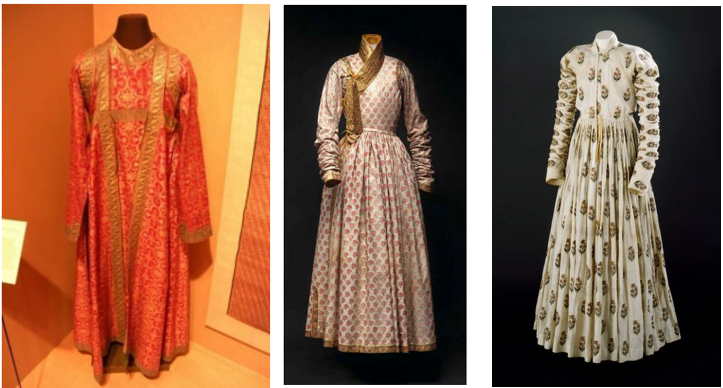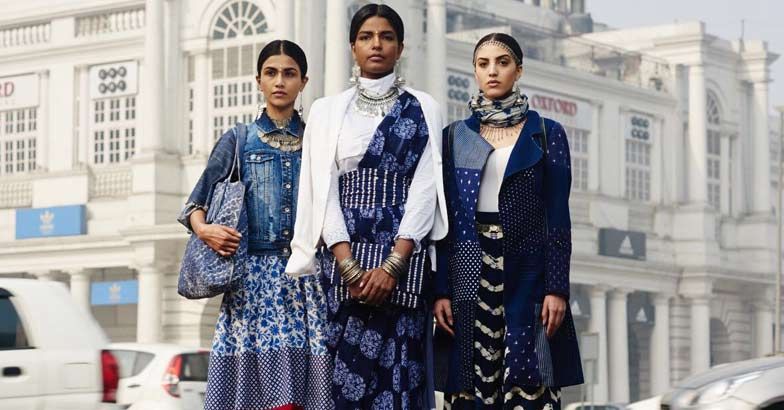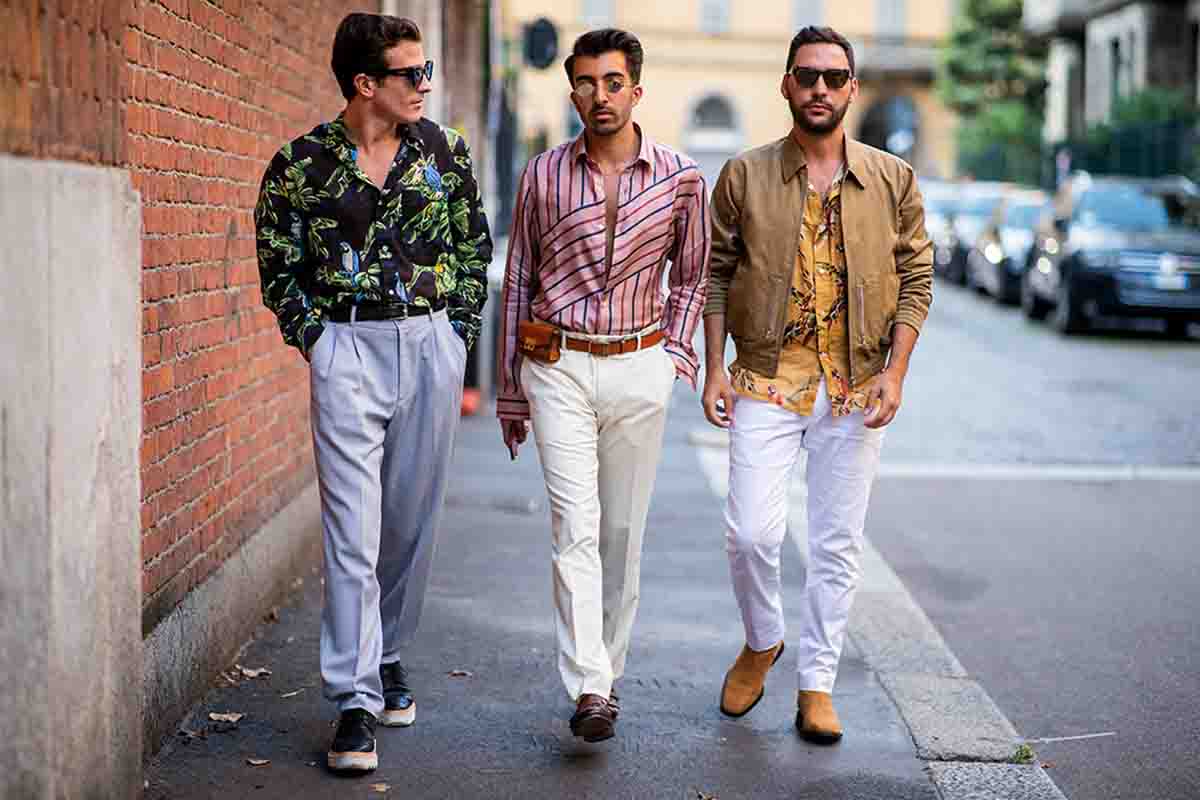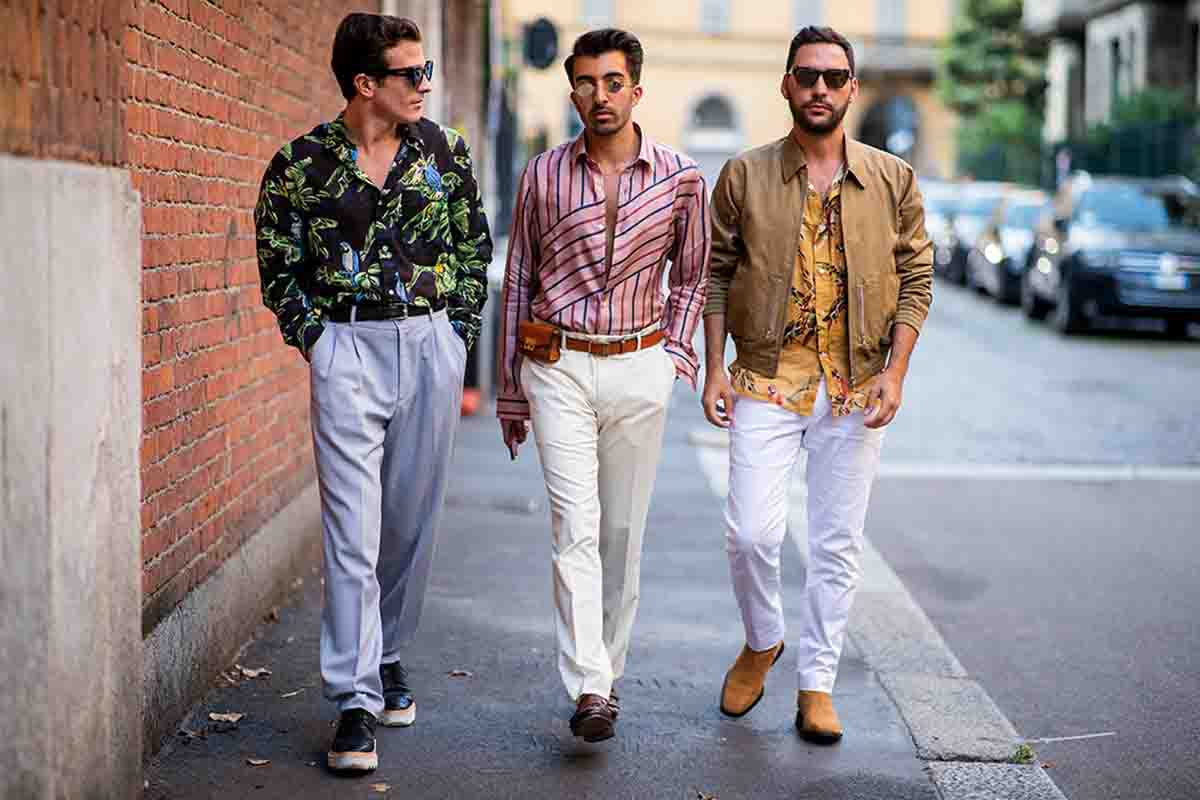Indian fashion has undergone a captivating journey of evolution, deeply rooted in the country’s rich cultural heritage and influenced by a myriad of historical, social and global factors. From the ancient civilizations of the Indus Valley, where intricate textiles and draping styles like the sari and dhoti emerged, to the cosmopolitan runways of contemporary India, the landscape of Indian fashion has continually transformed, reflecting the diverse tapestry of its people and their evolving identities. Each era has left its indelible mark on Indian attire, from the opulent fabrics and elaborate embroideries of the Mughal era to the fusion of traditional craftsmanship with modern sensibilities in the post-independence period. Today, Indian fashion stands at the intersection of tradition and innovation, where designers draw inspiration from centuries-old techniques while embracing global trends and where sustainability and ethical fashion practices are gaining prominence alongside a continued celebration of the country’s rich textile heritage. Amidst this dynamic evolution, Indian street-style fashion stores have emerged as a vibrant expression of individuality and cultural fusion. Here traditional garments are reimagined with a contemporary twist and influences from Bollywood, global fashion trends and local subcultures converge on bustling city streets, showcasing a kaleidoscope of colours, textures and eclectic aesthetics that mirror the pulse of modern India.
 In the vibrant tapestry of India’s fashion landscape, there’s a phenomenon that’s been steadily gaining momentum – the rise of street fashion. It’s a cultural revolution that’s not only transforming the way we dress but also redefining the very essence of style. From bustling metropolitan cities to quaint towns, the streets have become the runway and the youth, especially Gen Z and millennials, are the trendsetters.
The evolution of street-style store shopping in India is a fascinating journey that reflects the amalgamation of tradition and modernity, heritage and innovation. It’s a celebration of diversity, individuality and self-expression. What started as a subculture influenced by hip-hop, skateboarding and underground music scenes has now permeated mainstream fashion, inspiring designers, influencers and everyday people alike.
In the vibrant tapestry of India’s fashion landscape, there’s a phenomenon that’s been steadily gaining momentum – the rise of street fashion. It’s a cultural revolution that’s not only transforming the way we dress but also redefining the very essence of style. From bustling metropolitan cities to quaint towns, the streets have become the runway and the youth, especially Gen Z and millennials, are the trendsetters.
The evolution of street-style store shopping in India is a fascinating journey that reflects the amalgamation of tradition and modernity, heritage and innovation. It’s a celebration of diversity, individuality and self-expression. What started as a subculture influenced by hip-hop, skateboarding and underground music scenes has now permeated mainstream fashion, inspiring designers, influencers and everyday people alike.
 The rise of Indian Gen Z streetwear represents a dynamic fusion of global fashion influences and indigenous cultural elements, reflecting a burgeoning youth subculture’s quest for self-expression and identity. To understand this phenomenon, let’s delve into its history, the essence of streetwear in the Indian context and how Gen Z individuals embrace this style.
As this demographic continues to redefine fashion norms and push boundaries, streetwear in India will undoubtedly evolve, reflecting the ever-changing tastes and values of its youthful population. One of the defining characteristics of street fashion is its emphasis on comfort without compromising style. In a country known for its sweltering summers and diverse climatic conditions, practicality plays a significant role in fashion choices. This has led to the popularity of breathable fabrics, relaxed silhouettes and versatile pieces that can transition seamlessly from day to night.
The rise of Indian Gen Z streetwear represents a dynamic fusion of global fashion influences and indigenous cultural elements, reflecting a burgeoning youth subculture’s quest for self-expression and identity. To understand this phenomenon, let’s delve into its history, the essence of streetwear in the Indian context and how Gen Z individuals embrace this style.
As this demographic continues to redefine fashion norms and push boundaries, streetwear in India will undoubtedly evolve, reflecting the ever-changing tastes and values of its youthful population. One of the defining characteristics of street fashion is its emphasis on comfort without compromising style. In a country known for its sweltering summers and diverse climatic conditions, practicality plays a significant role in fashion choices. This has led to the popularity of breathable fabrics, relaxed silhouettes and versatile pieces that can transition seamlessly from day to night.
 1.Mixing Cultures:
Gen Z streetwear enthusiasts often blend elements of Western and Indian fashion, creating eclectic and personalized looks. This might involve pairing a traditional kurta with baggy jeans and sneakers or accessorizing with chunky silver jewellery. What sets street fashion apart is its democratic nature. Unlike high fashion, which can sometimes feel exclusive and elitist, street-style online stores are accessible to all. It’s about creativity, resourcefulness, and the ability to think outside the box. Whether you’re a student on a budget or a working professional with disposable income, there’s a place for you in the world of street fashion.
2.Embracing Diversity:
Indian Gen Z celebrates diversity and inclusivity through their fashion choices. They embrace gender-neutral clothing, body positivity, and ethnic diversity, challenging traditional beauty standards and norms. But street fashion isn’t just about casual dressing. It’s a versatile genre that encompasses a wide range of styles and aesthetics. From bohemian chic to minimalist sophistication, there’s something for everyone in the world of street fashion. Whether you’re heading to a music festival, a coffee date, or a night out with friends, there’s a street-style look that’s perfect for every occasion.
3.DIY Culture:
DIY (Do It Yourself) culture is prevalent among Gen Z streetwear aficionados. They customize their clothing with patches, embroidery, and hand-painted designs, adding a unique touch to mass-produced garments. For Gen Z and millennials, street fashion isn’t just about looking good; it’s about feeling confident, empowered, and authentic. It’s about embracing individuality and celebrating diversity. In a world where conformity often reigns supreme, street-style fashion stores serve as a rebellion—a way to assert one’s identity and stand out from the crowd.
4.Sustainable and Comfortable Fashion:
With growing environmental consciousness, many Gen Z individuals are gravitating towards sustainable streetwear brands that prioritize ethical production practices and eco-friendly materials. Comfort is key in street fashion, and this emphasis on practicality has led to the rise of athleisure—a fusion of athletic and leisurewear that’s as stylish as it is comfortable. From joggers and leggings to sports bras and hoodies, athleisure has become a wardrobe staple for many, blurring the lines between gym wear and streetwear.
5.Social Media Influence:
The advent of social media has played a significant role in propelling the street fashion movement forward. Platforms like Instagram, TikTok and Pinterest have become virtual runways where individuals showcase their style to a global audience. Influencers and fashion bloggers have emerged as the new tastemakers, shaping trends and inspiring millions with their curated looks and styling tips.
1.Mixing Cultures:
Gen Z streetwear enthusiasts often blend elements of Western and Indian fashion, creating eclectic and personalized looks. This might involve pairing a traditional kurta with baggy jeans and sneakers or accessorizing with chunky silver jewellery. What sets street fashion apart is its democratic nature. Unlike high fashion, which can sometimes feel exclusive and elitist, street-style online stores are accessible to all. It’s about creativity, resourcefulness, and the ability to think outside the box. Whether you’re a student on a budget or a working professional with disposable income, there’s a place for you in the world of street fashion.
2.Embracing Diversity:
Indian Gen Z celebrates diversity and inclusivity through their fashion choices. They embrace gender-neutral clothing, body positivity, and ethnic diversity, challenging traditional beauty standards and norms. But street fashion isn’t just about casual dressing. It’s a versatile genre that encompasses a wide range of styles and aesthetics. From bohemian chic to minimalist sophistication, there’s something for everyone in the world of street fashion. Whether you’re heading to a music festival, a coffee date, or a night out with friends, there’s a street-style look that’s perfect for every occasion.
3.DIY Culture:
DIY (Do It Yourself) culture is prevalent among Gen Z streetwear aficionados. They customize their clothing with patches, embroidery, and hand-painted designs, adding a unique touch to mass-produced garments. For Gen Z and millennials, street fashion isn’t just about looking good; it’s about feeling confident, empowered, and authentic. It’s about embracing individuality and celebrating diversity. In a world where conformity often reigns supreme, street-style fashion stores serve as a rebellion—a way to assert one’s identity and stand out from the crowd.
4.Sustainable and Comfortable Fashion:
With growing environmental consciousness, many Gen Z individuals are gravitating towards sustainable streetwear brands that prioritize ethical production practices and eco-friendly materials. Comfort is key in street fashion, and this emphasis on practicality has led to the rise of athleisure—a fusion of athletic and leisurewear that’s as stylish as it is comfortable. From joggers and leggings to sports bras and hoodies, athleisure has become a wardrobe staple for many, blurring the lines between gym wear and streetwear.
5.Social Media Influence:
The advent of social media has played a significant role in propelling the street fashion movement forward. Platforms like Instagram, TikTok and Pinterest have become virtual runways where individuals showcase their style to a global audience. Influencers and fashion bloggers have emerged as the new tastemakers, shaping trends and inspiring millions with their curated looks and styling tips.
 The rise of street fashion in India is a testament to the power of self-expression and individuality. It’s a movement fueled by creativity, inclusivity and a rebellious spirit. As Gen Z and millennials continue to slay the streets with their fashionable finds, one thing is clear: the future of fashion is bright, bold and unapologetically stylish. So, don your favourite sneakers, throw on a statement jacket, and hit the streets with confidence. After all, fashion is what you make it and there are no rules when it comes to expressing yourself. Embark on a stylish journey with LaFetch, where we applaud the ever-changing realm of fashion and the timeless allure of expressive attire. Discover the latest, most fashionable garments from your beloved brands and labels, all conveniently gathered at LaFetch. For additional details, explore our website.
The rise of street fashion in India is a testament to the power of self-expression and individuality. It’s a movement fueled by creativity, inclusivity and a rebellious spirit. As Gen Z and millennials continue to slay the streets with their fashionable finds, one thing is clear: the future of fashion is bright, bold and unapologetically stylish. So, don your favourite sneakers, throw on a statement jacket, and hit the streets with confidence. After all, fashion is what you make it and there are no rules when it comes to expressing yourself. Embark on a stylish journey with LaFetch, where we applaud the ever-changing realm of fashion and the timeless allure of expressive attire. Discover the latest, most fashionable garments from your beloved brands and labels, all conveniently gathered at LaFetch. For additional details, explore our website.
 In the vibrant tapestry of India’s fashion landscape, there’s a phenomenon that’s been steadily gaining momentum – the rise of street fashion. It’s a cultural revolution that’s not only transforming the way we dress but also redefining the very essence of style. From bustling metropolitan cities to quaint towns, the streets have become the runway and the youth, especially Gen Z and millennials, are the trendsetters.
The evolution of street-style store shopping in India is a fascinating journey that reflects the amalgamation of tradition and modernity, heritage and innovation. It’s a celebration of diversity, individuality and self-expression. What started as a subculture influenced by hip-hop, skateboarding and underground music scenes has now permeated mainstream fashion, inspiring designers, influencers and everyday people alike.
In the vibrant tapestry of India’s fashion landscape, there’s a phenomenon that’s been steadily gaining momentum – the rise of street fashion. It’s a cultural revolution that’s not only transforming the way we dress but also redefining the very essence of style. From bustling metropolitan cities to quaint towns, the streets have become the runway and the youth, especially Gen Z and millennials, are the trendsetters.
The evolution of street-style store shopping in India is a fascinating journey that reflects the amalgamation of tradition and modernity, heritage and innovation. It’s a celebration of diversity, individuality and self-expression. What started as a subculture influenced by hip-hop, skateboarding and underground music scenes has now permeated mainstream fashion, inspiring designers, influencers and everyday people alike.
Rise of street style fashion in India
 The rise of Indian Gen Z streetwear represents a dynamic fusion of global fashion influences and indigenous cultural elements, reflecting a burgeoning youth subculture’s quest for self-expression and identity. To understand this phenomenon, let’s delve into its history, the essence of streetwear in the Indian context and how Gen Z individuals embrace this style.
As this demographic continues to redefine fashion norms and push boundaries, streetwear in India will undoubtedly evolve, reflecting the ever-changing tastes and values of its youthful population. One of the defining characteristics of street fashion is its emphasis on comfort without compromising style. In a country known for its sweltering summers and diverse climatic conditions, practicality plays a significant role in fashion choices. This has led to the popularity of breathable fabrics, relaxed silhouettes and versatile pieces that can transition seamlessly from day to night.
The rise of Indian Gen Z streetwear represents a dynamic fusion of global fashion influences and indigenous cultural elements, reflecting a burgeoning youth subculture’s quest for self-expression and identity. To understand this phenomenon, let’s delve into its history, the essence of streetwear in the Indian context and how Gen Z individuals embrace this style.
As this demographic continues to redefine fashion norms and push boundaries, streetwear in India will undoubtedly evolve, reflecting the ever-changing tastes and values of its youthful population. One of the defining characteristics of street fashion is its emphasis on comfort without compromising style. In a country known for its sweltering summers and diverse climatic conditions, practicality plays a significant role in fashion choices. This has led to the popularity of breathable fabrics, relaxed silhouettes and versatile pieces that can transition seamlessly from day to night.


How Gen Z Wears Streetwear?
 1.Mixing Cultures:
Gen Z streetwear enthusiasts often blend elements of Western and Indian fashion, creating eclectic and personalized looks. This might involve pairing a traditional kurta with baggy jeans and sneakers or accessorizing with chunky silver jewellery. What sets street fashion apart is its democratic nature. Unlike high fashion, which can sometimes feel exclusive and elitist, street-style online stores are accessible to all. It’s about creativity, resourcefulness, and the ability to think outside the box. Whether you’re a student on a budget or a working professional with disposable income, there’s a place for you in the world of street fashion.
2.Embracing Diversity:
Indian Gen Z celebrates diversity and inclusivity through their fashion choices. They embrace gender-neutral clothing, body positivity, and ethnic diversity, challenging traditional beauty standards and norms. But street fashion isn’t just about casual dressing. It’s a versatile genre that encompasses a wide range of styles and aesthetics. From bohemian chic to minimalist sophistication, there’s something for everyone in the world of street fashion. Whether you’re heading to a music festival, a coffee date, or a night out with friends, there’s a street-style look that’s perfect for every occasion.
3.DIY Culture:
DIY (Do It Yourself) culture is prevalent among Gen Z streetwear aficionados. They customize their clothing with patches, embroidery, and hand-painted designs, adding a unique touch to mass-produced garments. For Gen Z and millennials, street fashion isn’t just about looking good; it’s about feeling confident, empowered, and authentic. It’s about embracing individuality and celebrating diversity. In a world where conformity often reigns supreme, street-style fashion stores serve as a rebellion—a way to assert one’s identity and stand out from the crowd.
4.Sustainable and Comfortable Fashion:
With growing environmental consciousness, many Gen Z individuals are gravitating towards sustainable streetwear brands that prioritize ethical production practices and eco-friendly materials. Comfort is key in street fashion, and this emphasis on practicality has led to the rise of athleisure—a fusion of athletic and leisurewear that’s as stylish as it is comfortable. From joggers and leggings to sports bras and hoodies, athleisure has become a wardrobe staple for many, blurring the lines between gym wear and streetwear.
5.Social Media Influence:
The advent of social media has played a significant role in propelling the street fashion movement forward. Platforms like Instagram, TikTok and Pinterest have become virtual runways where individuals showcase their style to a global audience. Influencers and fashion bloggers have emerged as the new tastemakers, shaping trends and inspiring millions with their curated looks and styling tips.
1.Mixing Cultures:
Gen Z streetwear enthusiasts often blend elements of Western and Indian fashion, creating eclectic and personalized looks. This might involve pairing a traditional kurta with baggy jeans and sneakers or accessorizing with chunky silver jewellery. What sets street fashion apart is its democratic nature. Unlike high fashion, which can sometimes feel exclusive and elitist, street-style online stores are accessible to all. It’s about creativity, resourcefulness, and the ability to think outside the box. Whether you’re a student on a budget or a working professional with disposable income, there’s a place for you in the world of street fashion.
2.Embracing Diversity:
Indian Gen Z celebrates diversity and inclusivity through their fashion choices. They embrace gender-neutral clothing, body positivity, and ethnic diversity, challenging traditional beauty standards and norms. But street fashion isn’t just about casual dressing. It’s a versatile genre that encompasses a wide range of styles and aesthetics. From bohemian chic to minimalist sophistication, there’s something for everyone in the world of street fashion. Whether you’re heading to a music festival, a coffee date, or a night out with friends, there’s a street-style look that’s perfect for every occasion.
3.DIY Culture:
DIY (Do It Yourself) culture is prevalent among Gen Z streetwear aficionados. They customize their clothing with patches, embroidery, and hand-painted designs, adding a unique touch to mass-produced garments. For Gen Z and millennials, street fashion isn’t just about looking good; it’s about feeling confident, empowered, and authentic. It’s about embracing individuality and celebrating diversity. In a world where conformity often reigns supreme, street-style fashion stores serve as a rebellion—a way to assert one’s identity and stand out from the crowd.
4.Sustainable and Comfortable Fashion:
With growing environmental consciousness, many Gen Z individuals are gravitating towards sustainable streetwear brands that prioritize ethical production practices and eco-friendly materials. Comfort is key in street fashion, and this emphasis on practicality has led to the rise of athleisure—a fusion of athletic and leisurewear that’s as stylish as it is comfortable. From joggers and leggings to sports bras and hoodies, athleisure has become a wardrobe staple for many, blurring the lines between gym wear and streetwear.
5.Social Media Influence:
The advent of social media has played a significant role in propelling the street fashion movement forward. Platforms like Instagram, TikTok and Pinterest have become virtual runways where individuals showcase their style to a global audience. Influencers and fashion bloggers have emerged as the new tastemakers, shaping trends and inspiring millions with their curated looks and styling tips.
 The rise of street fashion in India is a testament to the power of self-expression and individuality. It’s a movement fueled by creativity, inclusivity and a rebellious spirit. As Gen Z and millennials continue to slay the streets with their fashionable finds, one thing is clear: the future of fashion is bright, bold and unapologetically stylish. So, don your favourite sneakers, throw on a statement jacket, and hit the streets with confidence. After all, fashion is what you make it and there are no rules when it comes to expressing yourself. Embark on a stylish journey with LaFetch, where we applaud the ever-changing realm of fashion and the timeless allure of expressive attire. Discover the latest, most fashionable garments from your beloved brands and labels, all conveniently gathered at LaFetch. For additional details, explore our website.
The rise of street fashion in India is a testament to the power of self-expression and individuality. It’s a movement fueled by creativity, inclusivity and a rebellious spirit. As Gen Z and millennials continue to slay the streets with their fashionable finds, one thing is clear: the future of fashion is bright, bold and unapologetically stylish. So, don your favourite sneakers, throw on a statement jacket, and hit the streets with confidence. After all, fashion is what you make it and there are no rules when it comes to expressing yourself. Embark on a stylish journey with LaFetch, where we applaud the ever-changing realm of fashion and the timeless allure of expressive attire. Discover the latest, most fashionable garments from your beloved brands and labels, all conveniently gathered at LaFetch. For additional details, explore our website. 
